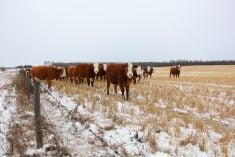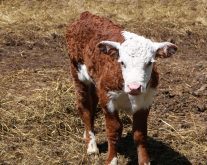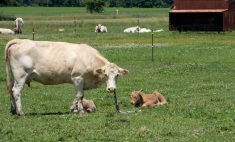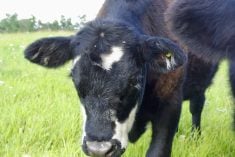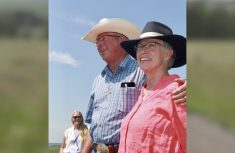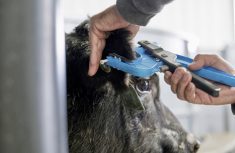In a previous article, I talked about selecting good cows to make a good cow herd. So, what do I expect a good cow to do?
- Calve unassisted every year in the first 25 days of the calving season. That means that she will breed in the first cycle of each breeding season.
- Be a very good and protective mother with an excellent udder.
- Raise an acceptable calf for my environment. The calf doesn’t have to be fantastic or exceptional.
- Never be doctored or handled except for routine immunizations for general herd health.
- Have good mobility — feet and legs.
- Not be wild or mean.
Read Also

Canadian Beef Check-Off Agency reports on investments and activities
The check-off agency’s work behind the scenes is what ensures cattle check-off dollars are invested wisely, accounted for transparently and deliver measurable value back to producers and importers.
Naturally, they won’t all be that good. But, over time, a lot of them will be.
The next question becomes, “Is my calving season going to allow a good percentage of my cows to meet these criteria, OR is there a calving season that would be better?” You might also ask if you should change the cows to profitably fit your calving season.
I firmly believe three management choices make a huge difference in cow-calf profitability: 1) properly managed “adaptive, multi-paddock grazing,” 2) cows that are adapted to your environment and management, and 3) a defined calving season that is most profitable for your operation — some want to “calve in sync with nature.”

Questions to ask
Several questions may be asked about a different calving season:
Will winter feed costs be significantly reduced? You might feed less because a gestating cow eats less than a lactating cow. You might graze longer because stockpiled range or pasture or crop residues have adequate quality for a pregnant cow but wouldn’t have for a cow in early lactation.
It can be difficult to maintain condition on cows in wintertime when they are expected to calve in February or March. However, if they are calving in late April or May, it is much easier to maintain condition through winter snow and cold. Lots of ranchers look for excuses to feed cows in the winter when they should be looking for reasons not to feed and for alternate sources of feed — stockpiled grasses, stockpiled crop residues, windrow or bale grazing, etc. — anything that will reduce the cost of winter feed while maintaining body condition.
Will costs for labour and facilities be reduced? Most ranches that have moved away from winter or early spring calving seasons have greatly reduced the need for calving-time labour and find almost no need for calving facilities.
What will happen to weaned calf crop percentage or number of calves weaned per 100 cows expected to calve? Many have felt like they experienced a reduction in calf sickness and death loss.
What will happen to the pregnancy rate? Several who have made sudden, big changes (perhaps February to May or March to June) have experienced fairly large reductions in pregnancy rates. Over time the pregnancy rates seem to improve. Some have decided to supplement protein during the breeding season to aid in late-season grass utilization. Others have taken more time to change calving seasons with seemingly fewer problems.
Two personal experiences have been in moving large numbers of cows from a March 1 calving date to an April 1 calving date, and another large group from early April to April 20. In both cases, we moved about 10 days at a time over a three- to five-year period and experienced no loss of pregnancy rate and an increase in weaned calf crop percentage. However, a later change in the first group from April 1 to May 1 from one year to the next was accompanied by a significant reduction in pregnancy rate. So, I wonder what might have been the result if we had taken several years to make the change.
Sometimes I wish I knew for sure what I think I know. I think there are epigenetic effects that allow cattle to adjust or adapt to new circumstances, but I don’t know for sure. However, if the change in calving season were made more slowly and reductions in breeding success began to occur, it would be much easier to stop and wait several years to see what would happen or to go back a week to 10 days.
What will happen to weaning weights? When weaning at the same date, it will typically reduce. Many who choose to calve later wean at the same time as usual and feed the calves separately or sell them and then expect their cows to graze well into or even through winter with little supplement. Others, however, are leaving calves on the cows even up to 10 months of age. In this case, they supplement the pairs, thinking it is cheaper to winter the calf that way than to separate it from the mother — better calf health, less total feed cost, much easier weaning and the mother is teaching the calf how to be a cow in the winter.
What about marketing? That too will have to change. I know of a few ranches that wean in the fall and sell very light calves to people who get the calves through winter fairly inexpensively and then take them to grass as stocker animals the following summer. However, the majority of late calvers, of whom I am aware, are keeping the calves through the next summer as yearlings. This aligns the greatest feed demand with greatest quantity and quality of feed available.

What do you want to accomplish?
I would not want to tell anyone what their “ideal” calving time should be, knowing how difficult that decision is on ranches that I manage. I can tell you what I want to accomplish and how I go about doing that. Then we can see where we align.
I want to reduce winter feed costs as much as possible. I want to make calving as simple and low-cost as possible with excellent calf health and survival. I want very good re-breed rates with acceptable calf growth.
Just before I retired, I helped a new manager who had worked with me choose a calving date for a newly acquired ranch using these ideas. I think we both thought it was probably not the exact correct date but could be easily adjusted to be earlier or later. Not long ago I asked him if he was still using the same calving date of April 20 in southeastern Montana. He said that he was, and I asked what he thought. He said, “When I’m calving, I think we are calving too early. When we are breeding, I think we are calving too late. Maybe that’s about right.”
He is starting to calve a little before all threats of blizzards and storms have passed. However, when his breeding season starts for that calving season, his grasses have begun to change and he fears that quality is diminishing. I know a May 1 calver not far away that is having good results. It would be interesting to know what 10 or 20 days later would do for him.
After these many years, I am very sure that, for most ranches, late spring or early summer calving is far better economically than late winter or early spring calving. Range management is probably critical to your choice. Ideally, you would manage for good quality and abundance of feed at a breeding season that would start your calving season after most threats of winter weather have passed.
Remember, no decision is irrevocable. Once you select a new calving date, your observation of the results will be very important. You should always be asking, “Did we go too far or not far enough?” Then you should let your observations tell you the truth. So, become a good observer.
Burke Teichert is a long-time manager of large ranches. He is also a consultant and speaker. Contact him at [email protected].



